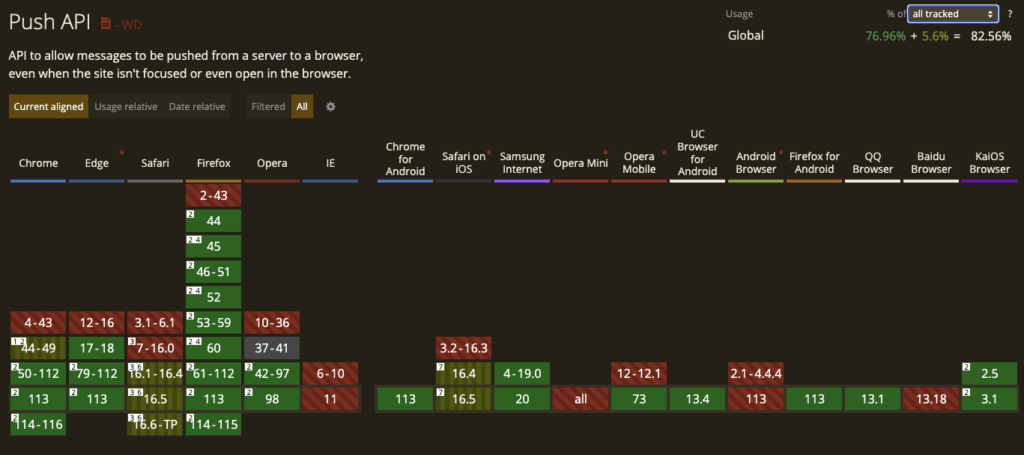Progressive Web Apps (PWA) have been around for almost a decade. Over the years, the technologies used in PWAs have been continuously developed, and the number of devices supporting them has increased. While alternative solutions like native apps and Accelerated Mobile Pages (AMP) also emerged, the question remains: Does PWA still have a place in the market in 2023 (and beyond)?
This article delves into the origins of PWA, their benefits, limitations, and current market trends, guiding you through the decision-making process for your web strategy.
The origins of PWA
In 2015, Google engineer Alex Russell introduced the term “PWA” in response to the challenges posed by hybrid approaches to app development. Combining web and native versions led to complexities in maintenance and deployment. PWA emerged as a game-changer, offering a unified version capable of adapting to user needs – a seamless blend of a classic website and a native app.
Benefits and limitations of Progressive Web Apps
Progressive Web Apps (PWA) offer a wide range of benefits that can revolutionize the way businesses engage with their users. By seamlessly combining the best features of traditional websites and native apps, PWAs provide an enhanced user experience, improved development efficiency, and cross-platform compatibility. However, like any technology, there are also certain limitations to consider when deciding to implement PWA functionality.
In this section, we will explore the benefits and limitations of PWA to help you make an informed decision about incorporating this technology into your web strategy. Let’s dive in!
Benefits of PWA
By embracing PWA, businesses and developers can unlock a range of benefits, including:
Enhanced user engagement:
- Users tend to return more frequently to installed applications than visited websites, leading to higher engagement rates.
- The seamless user experience across web and app-like interfaces boosts user satisfaction.
Development efficiency:
- A website with PWA support still remains a website, so there is no need to prepare separate versions for each operating system.
- Expanding app functionality with PWA features requires less effort than building native apps from scratch.
Additional functionalities:
- PWA allows users to install apps directly on their devices for quick access.
- Offline capabilities range from basic offline messaging to caching product information and blog content.
- Data synchronization ensures a seamless experience when reconnecting to the internet.
- Push notifications enable personalized communication.
- PWA leverages native device features such as geolocation and the camera.
Limitations of PWA
Looking at the list above, you might start to wonder if native apps are fading away. However, there are several areas where they have an advantage over PWA. While PWA offers significant advantages, there are a few limitations to consider.
Apple App Store support:
- Thanks to the newest technologies there is now a possibility to transform PWA into native iOS apps so they can be available at Apple’s App Store.
However, this feature is still in its early stage and developers may encounter some problems and restrictions while working with it.
Communication with native apps:
- PWA cannot directly communicate with other native apps, restricting certain functionalities.
Performance considerations:
- Native apps often outperform PWAs in resource-intensive tasks, boasting greater speed and efficiency.
Progressive Web Apps today
PWA has gained widespread support, expanding beyond Chrome to encompass the majority of the global market.
Increasing browser and device support:
- Apple’s recent iOS update allows PWA installation on the home screen and supports push notifications.
- Desktop systems are also recognizing and supporting PWA, blurring the lines between desktop and web applications.

PWA in e-commerce
PWA has shown significant potential in transforming the e-commerce landscape.
Improved User Experience:
- In a 2021 survey, 45% of North American and European e-commerce companies were implementing or evaluating PWA.
- 25% of respondents were undecided, while the remainder confirmed no plans for future PWA implementation and the remaining part confirmed the lack of plans to implement PWA in the future.
- Notable brands like Starbucks and Kubota experienced substantial user growth after introducing PWA versions, resulting in increased daily users and sales (that doubled for Starbucks and an increase of 192% for Kubota).
- In the case of the Debenhams chain of stores – mobile sales increased by 40%.
This data shows that adding PWA functionality to your store can significantly increase conversion with less effort, as adding PWA functionality to an e-commerce website is less resource-intensive compared to developing and maintaining a separate native app.
Is implementing Progressive Web Apps worthwhile?
Before implementing PWA, it is essential to evaluate your app’s specific user needs and consider the following:
User-centric approach:
- Identify the PWA functionalities that will benefit your app users the most.
- Utilize the functionalities that will expand your customer base, enhance user experience, and facilitate communication.
Customized implementation:
- PWA offers a range of functionalities, and not all need to be utilized simultaneously.
- Tailor the implementation to your specific requirements and align it with your users’ needs.
By carefully considering the potential benefits and limitations, you can make an informed decision about integrating PWA functionality into your website.
GET IN TOUCH
Ready to unlock the potential of Progressive Web Apps for your business?
Contact us now to discuss how PWA functionalities can benefit your app users, expand your customer base, and enhance your user experience.























